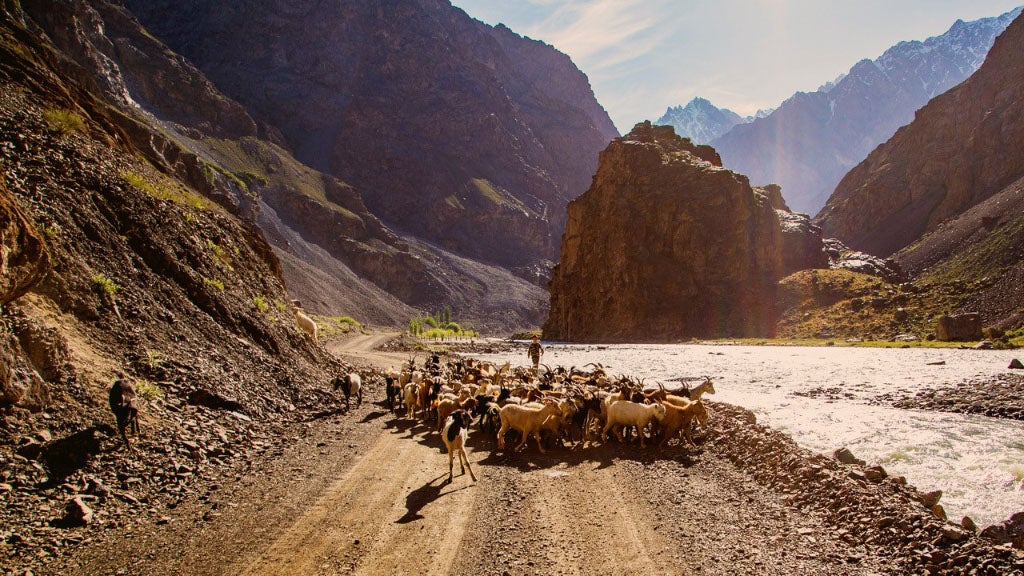 Central Asia mountains
Central Asia mountains
The mountains of Central Asia are truly breathtaking. Driving from Samarkand to Dushanbe recently, we passed through stretches of untouched, captivating mountain ranges and landscapes emblematic of the Silk Road along which Asia and Europe have traded, mingled, and negotiated for over four centuries.
Yet the mountains of Central Asia provide more than a breathtaking view. They are essential to the region’s resilience – people’s day-to-day lives, health, and future.
Here, mountain glaciers hold vast amounts of water that flow downstream to rivers to provide water for 90% of the population. Local communities are heavily dependent on the quantity and regularity of the water supply for their households, to grow food to eat and to sell, and to simply live.
Credited as the center of origin and of diversity for many globally significant fruit and nut tree species (apples, grapes, walnuts), Central Asia’s land is now threatened by expanded agriculture land, logging and pastoral activities. These increasing human pressures have led to land degradation, erosion, and loss of vegetation cover.
Land degradation – land losing its natural productivity – costs, on average, four percent of the countries’ GDP. In Tajikistan, we estimated that land degradation in the mountains cost the country between $ 539 million and $ 950 million (equivalent to 8.1% and 13.4% of GDP) in 2019.
The cost of inaction is five times higher.
Climate change and global warming have resulted in intense glacier melting and higher incidences of avalanches, floods, landslides, mudflows and extreme weather. Mountains are prone to disasters due to their steep and often unstable slopes, and frequent extreme weather.
In tight valleys, one event may trigger secondary, cascading hazards. Since 1990, land degradation-related disasters have affected the lives of over 10 million people in Central Asia and caused damages worth around $2.5 billion. In the Kyrgyz Republic, rain could trigger over 5,000 potential landslides.
More needs to be done to reduce the huge impacts disasters have on the mountainous countries of Central Asia.
Weather-related calamities are exerting increasing pressure on natural resources but also on livelihoods. Changes in water availability alone have deeply disrupted farming, fisheries, forests work, and livestock, all core activities providing food, revenue and a safety net.
Mountain communities are particularly affected, as they are already vulnerable: living in secluded areas, they lack access to basic infrastructure and services and are also often marginalized, getting less political attention and less public investment.

Upon our return from the trip, our attention remained firmly on Tajikistan’s mountains: how can we maintain their splendor while making their sustainable use also possible?
Encouraged by Central Asian leaders’ new commitment to natural landscape restoration through the 2018 Astana Resolution and the ECCA30 Initiative, the World Bank started to design a regional RESILAND CA+ Program (Uzbekistan, Kazakhstan, Tajikistan. It reflects countries’ joint vision and collaborative action to increase the resilience of cross-boundary landscapes.
Investing in the restoration of these landscapes will make a big difference: agriculture productivity can increase, green jobs can be created, ecotourism can start, infrastructure can be made more resilient and life can be sustained, if not transformed. RESILAND builds on the proven results of the Climate Adaptation and Mitigation Program for Aral Sea Basin project.
The program is crowdsourcing innovative ideas and financing for landscape restoration in the Aral Sea basin through the Disruptive Tech Challenge launched in November 2020.
At the Bank, we are also engaged in disaster-risk management in the region, supporting improved climate, water, and weather forecasting and information services, through the Central Asia Hydrometeorology Modernization Project. This is critical as farmers’ livelihoods depend on their ability to protect their assets from droughts, storms, and extreme temperatures; and public disaster management agencies need these forecasts to determine when to issue alerts. In addition, national projects in the Kyrgyz Republic and Tajikistan are reducing risks and building resilience.
As we celebrate International Mountain Day, let’s continue to seize the huge opportunities to protect and restore Central Asia’s natural landscapes and ecosystems , so that the people and communities of the region can live better, healthier, more prosperous lives.




Join the Conversation